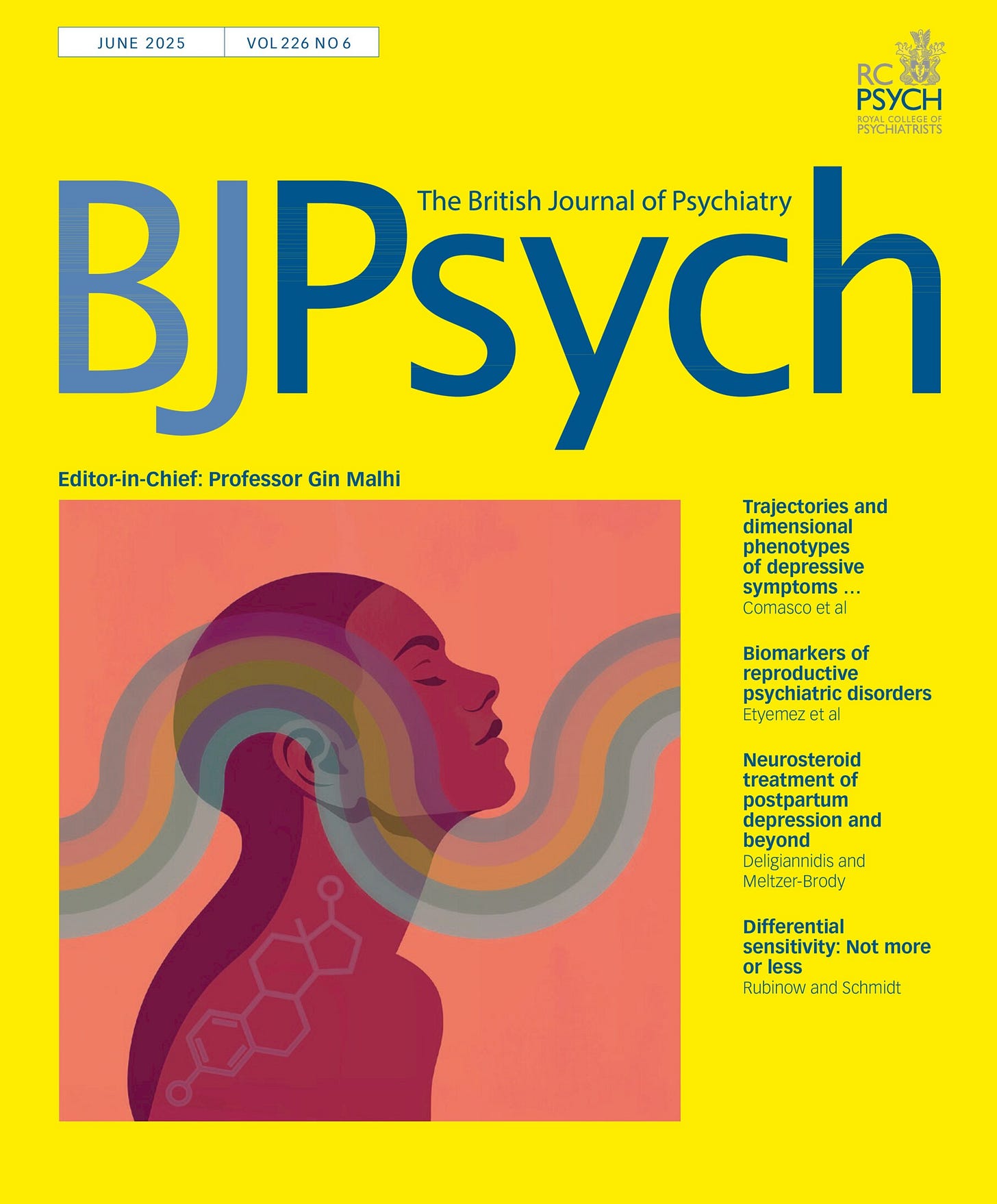Mixed Bag #24: Thomas Reilly on Ovarian Hormones in Mental Disorders
“Mixed Bag” is a series where I ask an expert to select 5 items to explore a particular topic: a book, a concept, a person, an article, and a surprise item (at the expert’s discretion). For each item, they have to explain why they selected it and what it signifies. — Awais Aftab
Thomas Reilly is a DPhil student at the University of Oxford; his doctoral thesis is on the effect of the menstrual cycle on psychosis. He is also a specialist registrar in psychiatry at South London and Maudsley, based at the National Female Hormone Clinic. He writes on Substack at Rational Psychiatry.
Article — Peter Schmidt et al. (1998) Differential behavioral effects of gonadal steroids in women with and in those without premenstrual syndrome. New England Journal of Medicine.
I first became interested in ovarian hormones (estradiol and progesterone) after meeting patients who experienced psychotic episodes in synchrony with their menstrual cycle. While ‘menstrual psychosis’ is a rare condition, the menstrual cycle can have broader impacts on mental health across diagnoses. At that time, I didn’t appreciate how much research had already been done into how ovarian hormones can impact mental states. This was a major blind spot on my part, despite being someone who leaned towards biological research in psychiatry.
There are features that make these hormones amenable to being studied in experimental settings: we already have ways to suppress them and also to administer exogenous versions. A classic experiment comes from a collaboration between Peter Schmidt and David Rubinow at NIMH. Their study showed that suppression of ovarian hormones with the gonadotropin-releasing hormone analogue, leuprolide, could ameliorate depressive symptoms in women with premenstrual syndrome. Adding back either estradiol or progesterone caused symptoms to return. In healthy women, neither suppressing ovarian hormones nor adding them back influenced depressive symptoms. The study design, a cross-over double-blind placebo-controlled trial, can give us confidence that the effect was causal.
The study showed that suppressing ovarian hormones could alleviate premenstrual symptoms, and conversely, reintroducing either hormone caused symptoms to recur; as good causative evidence as we get in psychiatry. A follow-up study replicated the finding that adding back hormones initially causes symptoms to return, but after two months of consistent hormone levels, the symptoms dissipated again. This has led to our current conceptualization of premenstrual syndromes: that the fluctuation in hormone levels causes symptoms, while steady levels of hormones (whether that be through artificial suppression of the ovarian axis or through the administration of exogenous hormones) can control symptoms.
This work directly leads to the concept by which we think about hormones causing mental health problems, not just associated with the menstrual cycle but at other times of hormone fluctuation: differential hormone sensitivity.
Concept — Differential hormone sensitivity
This concept ties together various strands of clinical findings and research evidence to form a coherent account of why some women experience mental health problems relating to times of hormone fluctuation. Firstly, there is no consistent evidence that women who experience disorders like premenstrual dysphoric disorder, postpartum depression, or perimenopausal depression have differences in circulating levels of ovarian hormones compared with healthy women. Secondly, we know that experiencing mental health symptoms relating to one reproductive event (premenstrual dysphoric disorder) increases the risk at others (postpartum depression). Thirdly, as previously described, we know that fluctuations in hormones rather than consistently high or low levels seem to be responsible for mental health symptoms.
Differential sensitivity proposes that a subgroup of the female population are susceptible to changes in circulating ovarian hormones, manifesting in affective symptoms. The brain mechanisms behind this hormonal sensitivity are not entirely known but are presumed to relate to differential expression of receptors that the hormones (or their metabolites) act on.
One implication of hormone sensitivity is that we might be able to treat mental health problems related to times of hormonal fluctuation (menstrual cycle, childbirth, menopause transition) through hormone stabilization. We have various strategies to supress hormones while exogenous ovarian hormones (think hormonal contraception or menopausal hormone therapy) are very commonly prescribed medications.
An excellent updated summary of this concept was published in the June edition of the British Journal of Psychiatry (a special issue on ovarian hormones), Differential sensitivity: not more or less by, you guessed it, Schmidt and Rubinow.

Person — Tory Eisenlohr-Moul
Of all researchers that I know, Tory most encapsulates the research tradition of Schmidt and Rubinow; her lab examines the influence of ovarian hormones on premenstrual disorders and suicidal ideation using experimental paradigms. She is additionally a clinical psychologist, specializing in premenstrual disorders. She has spearheaded the International Association for Premenstrual Disorders, a wonderful organization that provides evidence-based resources for patients, clinicians, and researchers. I recommend this organization to every patient with menstrual-related disorders whom I meet.
The rigor of her work has been a source of inspiration (perhaps aspiration) for me. Her 2020 review paper, Premenstrual Disorders: A Primer and Research Agenda for Psychologists, sums up the clinical understanding and research landscape of this decade. Her 2021 paper (first author Katja Schmalenberger), How to study the menstrual cycle: Practical tools and recommendations, is the benchmark for robust menstrual cycle research.
Tory is a strong advocate for prospective charting of symptoms to make a diagnosis of premenstrual dysphoric disorder (a stipulation for a confirmed DSM-5 diagnosis but not essential for ICD-11). Using this strict requirement, the point prevalence of premenstrual dysphoric disorder is as low as 3.2% in a meta-analysis we published together in 2024, less than half the rate if symptom charting was not used. Such a low prevalence gives reassurance that current diagnostic criteria are not medicalizing a normal part of female physiology (if anything, the criteria might be too strict).
Book — The Maudsley Prescribing Guidelines in Psychiatry
When I first started at the Maudsley training programme more than a decade ago, there were many pinch-yourself moments. I was suddenly walking past the offices of academics whose papers I’d read during medical school and seeing clinicians who had shaped the face of UK psychiatry. One such moment came when I was handed my first copy of the Maudsley Prescribing Guidelines from the pharmacy. These guidelines have been driven by the Maudsley’s chief pharmacist, David Taylor. They succinctly summarize the evidence for pharmacological treatment of mental disorders. The clarity of writing and distillation of evidence (largely attributable to David’s editorial zeal) makes the text suitable for day-to-day clinical use, as well as exam revision.
This year’s 15th edition was particularly special for me, as I was asked to contribute to a new section on premenstrual syndrome. Unusually for psychiatric guidelines, we recommend both hormonal (e.g. combined oral contraceptives, transdermal estradiol, gonadotropin-releasing hormone analogues) and non-hormonal (e.g. SSRIs, treatment of psychiatric comorbidity) approaches. Often treatment for premenstrual disorders is tailored to the patient’s preference and past experience. This flexibility around management strategies and availability of effective medication makes treating these conditions incredibly satisfying.
The inclusion of premenstrual disorders, alongside the additions of menopause and hormone replacement therapy, highlights the recognition among clinicians that ovarian hormones have an important role in mental disorders and the appetite for guidance on hormonal treatments.
Surprise item — Malpractice, Season 2
This British TV drama, written by Grace Ofori-Attah, who previously worked as a Consultant Psychiatrist in London, portrays a psychiatry specialist registrar working in a pressurized NHS. The plot centers around the assessment and (mis)management of a new mother experiencing a mental health crisis. Like many medical thrillers, the plot twists can stretch credulity, but the writer’s first-hand experience of psychiatry makes the representation of UK mental health services uncomfortably true to life. Competing demands when on-call, medical emergencies on psychiatric wards, and most of all, the rapid fluctuation of mental states in postpartum psychosis ring true. For all his flaws, cavalier attitude, and possibly unethical behavior (a plotline is whether he will be struck off the medical register), the protagonist James Ford clearly cares about his patients and is trying to do his best for them, despite the system he is working within. I can’t be the only one who partly identified with him.
See previous posts in the “Mixed Bag” series.
Psychiatry at the Margins is a reader-supported publication. Subscribe here.




This is a timely read for me. I have been experiencing severe PMDD for a year. My cycles are also long (~40 days).
I ovulate “on time” but get stuck in my luteal phase for 2 weeks. My depressive symptoms hit in the second week. The second I bleed I am back to normal. It is uncanny.
It’s really interesting to read about the current research and theories. Makes me hopeful for the future.
Really nice item in the bag!